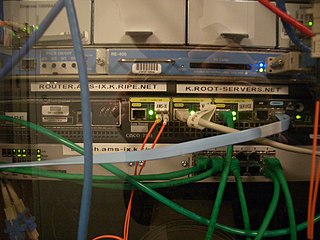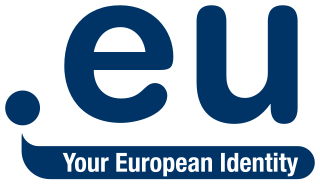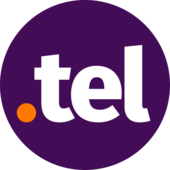The Domain Name System (DNS) is a hierarchical and distributed naming system for computers, services, and other resources in the Internet or other Internet Protocol (IP) networks. It associates various information with domain names assigned to each of the associated entities. Most prominently, it translates readily memorized domain names to the numerical IP addresses needed for locating and identifying computer services and devices with the underlying network protocols. The Domain Name System has been an essential component of the functionality of the Internet since 1985.

The Internet Corporation for Assigned Names and Numbers is a global multistakeholder group and nonprofit organization head-quartered in the United States responsible for coordinating the maintenance and procedures of several databases related to the namespaces and numerical spaces of the Internet, ensuring the Internet's stable and secure operation. ICANN performs the actual technical maintenance work of the Central Internet Address pools and DNS root zone registries pursuant to the Internet Assigned Numbers Authority (IANA) function contract. The contract regarding the IANA stewardship functions between ICANN and the National Telecommunications and Information Administration (NTIA) of the United States Department of Commerce ended on October 1, 2016, formally transitioning the functions to the global multistakeholder community.
A top-level domain (TLD) is one of the domains at the highest level in the hierarchical Domain Name System of the Internet after the root domain. The top-level domain names are installed in the root zone of the name space. For all domains in lower levels, it is the last part of the domain name, that is, the last non empty label of a fully qualified domain name. For example, in the domain name www.example.com, the top-level domain is .com. Responsibility for management of most top-level domains is delegated to specific organizations by the ICANN, an Internet multi-stakeholder community, which operates the Internet Assigned Numbers Authority (IANA), and is in charge of maintaining the DNS root zone.

In the Internet, a domain name is a string that identifies a realm of administrative autonomy, authority or control. Domain names are often used to identify services provided through the Internet, such as websites, email services and more. Domain names are used in various networking contexts and for application-specific naming and addressing purposes. In general, a domain name identifies a network domain or an Internet Protocol (IP) resource, such as a personal computer used to access the Internet, or a server computer.

A root name server is a name server for the root zone of the Domain Name System (DNS) of the Internet. It directly answers requests for records in the root zone and answers other requests by returning a list of the authoritative name servers for the appropriate top-level domain (TLD). The root name servers are a critical part of the Internet infrastructure because they are the first step in resolving human-readable host names into IP addresses that are used in communication between Internet hosts.

.eu is the country code top-level domain (ccTLD) for the European Union (EU). Launched on 7 December 2005, the domain is available for any person, company or organization based in the European Union. This was extended to the European Economic Area in 2014, after the regulation was incorporated into the EEA Agreement, and hence is also available for any person, company or organization based in Iceland, Liechtenstein and Norway. The TLD is administered by EURid, a consortium originally consisting of the national ccTLD registry operators of Belgium, Sweden, and Italy, joined later by the national registry operator of the Czech Republic. Trademark owners were able to submit registrations through a sunrise period, in an effort to prevent cybersquatting. Full registration started on 7 April 2006.
The Internet uses the Domain Name System (DNS) to associate numeric computer IP addresses with human-readable names. The top level of the domain name hierarchy, the DNS root, contains the top-level domains that appear as the suffixes of all Internet domain names. The most widely used DNS root is administered by the Internet Corporation for Assigned Names and Numbers (ICANN). In addition, several organizations operate alternative DNS roots, often referred to as alt roots. These alternative domain name systems operate their own root name servers and commonly administer their own specific name spaces consisting of custom top-level domains.

.info is a generic top-level domain (gTLD) in the Domain Name System (DNS) of the Internet. The name is derived from information, although registration requirements do not prescribe any particular purpose.
A domain name registrar is a company that manages the reservation of Internet domain names. A domain name registrar must be accredited by a generic top-level domain (gTLD) registry or a country code top-level domain (ccTLD) registry. A registrar operates in accordance with the guidelines of the designated domain name registries.

.xxx is a sponsored top-level domain (sTLD) intended as a voluntary option for pornographic sites on the Internet. The sponsoring organization is the International Foundation for Online Responsibility (IFFOR). The registry is operated by ICM Registry LLC. The ICANN Board voted to approve the sTLD on 18 March 2011. It went into operation on 15 April 2011.
The domain name arpa is a top-level domain (TLD) in the Domain Name System (DNS) of the Internet. It is used predominantly for the management of technical network infrastructure. Prominent among such functions are the subdomains in-addr.arpa and ip6.arpa, which provide namespaces for reverse DNS lookup of IPv4 and IPv6 addresses, respectively.

A DNS zone is a specific portion of the DNS namespace in the Domain Name System (DNS), which a specific organization or administrator manages. A DNS zone is an administrative space allowing more granular control of the DNS components, such as authoritative nameserver. The DNS is broken up into different zones, distinctly managed areas in the DNS namespace. DNS zones are not necessarily physically separated from one another; however, a DNS zone can contain multiple subdomains, and multiple zones can exist on the same server.
DNS spoofing, also referred to as DNS cache poisoning, is a form of computer security hacking in which corrupt Domain Name System data is introduced into the DNS resolver's cache, causing the name server to return an incorrect result record, e.g. an IP address. This results in traffic being diverted to any computer that the attacker chooses.
A Name Authority Pointer (NAPTR) is a type of resource record in the Domain Name System of the Internet.
WHOIS is a query and response protocol that is used for querying databases that store an Internet resource's registered users or assignees. These resources include domain names, IP address blocks and autonomous systems, but it is also used for a wider range of other information. The protocol stores and delivers database content in a human-readable format. The current iteration of the WHOIS protocol was drafted by the Internet Society, and is documented in RFC 3912.
DNS hijacking, DNS poisoning, or DNS redirection is the practice of subverting the resolution of Domain Name System (DNS) queries. This can be achieved by malware that overrides a computer's TCP/IP configuration to point at a rogue DNS server under the control of an attacker, or through modifying the behaviour of a trusted DNS server so that it does not comply with internet standards.

.biz is a generic top-level domain (gTLD) in the Domain Name System of the Internet. It is intended for registration of domains to be used by businesses. The name is a phonetic spelling of the first syllable of business.
A landrush period is the time during which domain names are available for registration, usually to a closed group, to entities that do not own a trademark in the name they wish to register, for example generic terms like loan or car, and thus would not qualify for registration during the sunrise period. Orders may or may not be treated on a first-come-first-served basis. This period follows the sunrise period just after the launch of a new top-level domain or second-level domain during which, for example, owners of trademarks may register a domain name containing the owned mark, but a landrush period precedes a period of general availability, when any qualifying entity can register any name on a first come first-served basis.
Domain registration is the process of acquiring a domain name from a domain name registrar.

.wiki is a top-level domain name. Its purpose is to denote websites that are wikis. It was proposed in ICANN's New generic top-level domain (gTLD) Program, and became available to the general public on May 26, 2014. Top Level Design is the domain name registry for the string.










